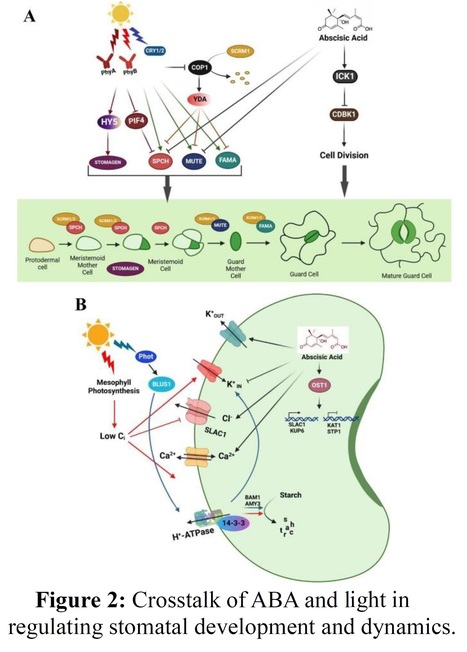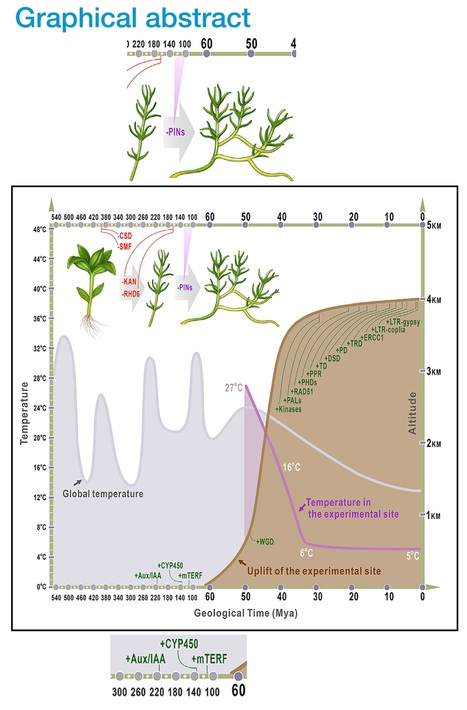 Your new post is loading...
 Your new post is loading...
Authors: Kalyan Mahapatra, Shubhi Dwivedi, Arpan Mukherjee, Ajar Anupam Pradhan, Kavuri Venkateswara Rao, Deeksha Singh, Lavanya Bhagavatula and Sourav Datta.
Journal of Experimental Botany (2024)
Abstract: "The exogenous light cues and the phytohormone Abscisic acid (ABA) regulate several aspects of plant growth and development. In recent years, the role of the crosstalk between the light and ABA signaling pathways in regulating different physiological processes has become increasingly evident. This includes the regulation of germination and early seedling development, control of stomatal development and conductance, growth and development of roots, buds, branches, and regulation of flowering. Light and ABA signaling cascades have various convergence points at both DNA and protein levels. The molecular crosstalk involves several light signaling factors like HY5, COP1, PIFs and BBXs that integrate with ABA signaling components like the PYL receptors and ABI5. Especially, ABI5 and PIF4 promoters serve as key “hotspots” for the integration of these two pathways. Plants acquired both light and ABA signaling pathways before they colonized land almost 500 million years ago. In this review, we discuss the recent advances in the interplay of light and ABA signaling regulating plant development and provide an overview of the evolution of these two pathways."
Authors: Shuka Ikematsu, Tatsushi Umase, Mako Shiozaki, Sodai Nakayama, Fuko Noguchi, Tomoaki Sakamoto, Hongwei Hou, Gholamreza Gohari, Seisuke Kimura and Keiko U. Torii.
Current Biology (2023)
Editor's view: The Brassicaceae amphibious plant Rorippa aquatica dramatically changes leaf morphology and function under water. Ikematsu et al. reveal that submergence triggers rapid inhibition of stomatal development through the redlight- mediated ethylene pathway. Blue light counteracts this, and jasmonic acid attenuates this adaptive response to submergence.
Highlights: • Molecular framework of stomata development in R. aquatica rewired from Arabidopsis • Morphological heterophylly and stomatal development uncoupled in R. aquatica • Ethylene rapidly inhibits RaSPCH/RaMUTE expression and stomatal development • Opposing role of red and blue light in inhibiting stomatal development
Abstract: "Land plants have evolved the ability to cope with submergence. Amphibious plants are adapted to both aerial and aquatic environments through phenotypic plasticity in leaf form and function, known as heterophylly. In general, underwater leaves of amphibious plants are devoid of stomata, yet their molecular regulatory mechanisms remain elusive. Using the emerging model of the Brassicaceae amphibious species Rorippa aquatica, we lay the foundation for the molecular physiological basis of the submergence-triggered inhibition of stomatal development. A series of temperature shift experiments showed that submergence-induced inhibition of stomatal development is largely uncoupled from morphological heterophylly and likely regulated by independent pathways. Submergence-responsive transcriptome analysis revealed rapid reprogramming of gene expression, exemplified by the suppression of RaSPEECHLESS and RaMUTE within 1 h and the involvement of light and hormones in the developmental switch from terrestrial to submerged leaves. Further physiological studies place ethylene as a central regulator of the submergence-triggered inhibition of stomatal development. Surprisingly, red and blue light have opposing functions in this process: blue light promotes, whereas red light inhibits stomatal development, through influencing the ethylene pathway. Finally, jasmonic acid counteracts the inhibition of stomatal development, which can be attenuated by the red light. The actions and interactions of light and hormone pathways in regulating stomatal development in R. aquatica are different from those in the terrestrial species, Arabidopsis thaliana. Thus, our work suggests that extensive rewiring events of red light to ethylene signaling might underlie the evolutionary adaption to water environment in Brassicaceae."
Authors: Shenqi Wang, Zimin Zhou, Rini Rahiman, Grace Sheen Yee Lee, Yuan Kai Yeo, Xin Yang and On Sun Lau.
Nature Communications (2021)
Abstract: "Developmental outcomes are shaped by the interplay between intrinsic and external factors. The production of stomata—essential pores for gas exchange in plants—is extremely plastic and offers an excellent system to study this interplay at the cell lineage level. For plants, light is a key external cue, and it promotes stomatal development and the accumulation of the master stomatal regulator SPEECHLESS (SPCH). However, how light signals are relayed to influence SPCH remains unknown. Here, we show that the light-regulated transcription factor ELONGATED HYPOCOTYL 5 (HY5), a critical regulator for photomorphogenic growth, is present in inner mesophyll cells and directly binds and activates STOMAGEN. STOMAGEN, the mesophyll-derived secreted peptide, in turn stabilizes SPCH in the epidermis, leading to enhanced stomatal production. Our work identifies a molecular link between light signaling and stomatal development that spans two tissue layers and highlights how an environmental signaling factor may coordinate growth across tissue types. Light promotes stomatal development in plants. Here Wang et al. show that light stimulates stomatal development via the HY5 transcription factor which induces expression of STOMAGEN, a mesophyll-derived secreted peptide, that in turn leads to stabilization of a master regulator of stomatal development in the epidermis."
|
Authors: Ruoyang Hu, Xuedong Li, Yong Hu, Runjie Zhang, Qiang Lv, Min Zhang, Xianyong Sheng, Feng Zhao, Zhijia Chen, Yuhan Ding, Huan Yuan, Xiaofeng Wu, Shuang Xing, Xiaoyu Yan, Fang Bao, Ping Wan, Lihong Xiao, Xiaoqin Wang, Wei Xiao, Eva L. Decker, Nico van Gessel, Hugues Renault, Gertrud Wiedemann, Nelly A. Horst, Fabian B. Haas, Per K.I. Wilhelmsson, Kristian K. Ullrich, Eva Neumann, Bin Lv, Chengzhi Liang, Huilong Du, Hongwei Lu, Qiang Gao, Zhukuan Cheng, Hanli You, Peiyong Xin, Jinfang Chu, Chien-Hsun Huang, Yang Liu, Shanshan Dong, Liangsheng Zhang, Fei Chen, Lei Deng, Fuzhou Duan, Wenji Zhao, Kai Li, Zhongfeng Li, Xingru Li, Hengjian Cui, Yong E. Zhang, Chuan Ma, Ruiliang Zhu, Yu Jia, Meizhi Wang, Mitsuyasu Hasebe, Jinzhong Fu, Bernard Goffinet, Hong Ma, Stefan A. Rensing, Ralf Reski and Yikun He.
Cell (2023)
Editor's view: Field observations of Takakia, a highly adapted moss facing extinction in the Tibetan Plateau, integrated with an evolutionary framework provide insights into when its distinct features emerged relative to the geological events that shape this extreme environment.
Highlights • Steepest temperature increase at 4 km elevation threatens highly adapted moss species • Sequenced genome with highest number of fast-evolving genes under positive selection • Adaptation to severe UV-B radiation and freezing likely evolved at high altitudes • Morphological peculiarities of Takakia plants likely evolved earlier than 165 mya
Abstract: "The most extreme environments are the most vulnerable to transformation under a rapidly changing climate. These ecosystems harbor some of the most specialized species, which will likely suffer the highest extinction rates. We document the steepest temperature increase (2010–2021) on record at altitudes of above 4,000 m, triggering a decline of the relictual and highly adapted moss Takakia lepidozioides. Its de-novo-sequenced genome with 27,467 protein-coding genes includes distinct adaptations to abiotic stresses and comprises the largest number of fast-evolving genes under positive selection. The uplift of the study site in the last 65 million years has resulted in life-threatening UV-B radiation and drastically reduced temperatures, and we detected several of the molecular adaptations of Takakia to these environmental changes. Surprisingly, specific morphological features likely occurred earlier than 165 mya in much warmer environments. Following nearly 400 million years of evolution and resilience, this species is now facing extinction."
Authors: James W. Clark, Brogan J. Harris, Alexander J. Hetherington, Natalia Hurtado-Castano, Robert A. Brench, Stuart Casson, Tom A. Williams, Julie E. Gray and Alistair M. Hetherington.
Current Biology (2022)
Editor's view: Clark et al. highlight palaeontological, phylogenomic, molecular and physiological insights into the origin and evolution of stomata, and use this evidence to help clarify the evolution of stomatal function.
Abstract: "The acquisition of stomata is one of the key innovations that led to the colonisation of the terrestrial environment by the earliest land plants. However, our understanding of the origin, evolution and the ancestral function of stomata is incomplete. Phylogenomic analyses indicate that, firstly, stomata are ancient structures, present in the common ancestor of land plants, prior to the divergence of bryophytes and tracheophytes and, secondly, there has been reductive stomatal evolution, especially in the bryophytes (with complete loss in the liverworts). From a review of the evidence, we conclude that the capacity of stomata to open and close in response to signals such as ABA, CO2 and light (hydroactive movement) is an ancestral state, is present in all lineages and likely predates the divergence of the bryophytes and tracheophytes. We reject the hypothesis that hydroactive movement was acquired with the emergence of the gymnosperms. We also conclude that the role of stomata in the earliest land plants was to optimise carbon gain per unit water loss. There remain many other unanswered questions concerning the evolution and especially the origin of stomata. To address these questions, it will be necessary to: find more fossils representing the earliest land plants, revisit the existing early land plant fossil record in the light of novel phylogenomic hypotheses and carry out more functional studies that include both tracheophytes and bryophytes."
|



 Your new post is loading...
Your new post is loading...











